
Lane Motor Museum, Nashville
Tatra Of Czechoslovakia
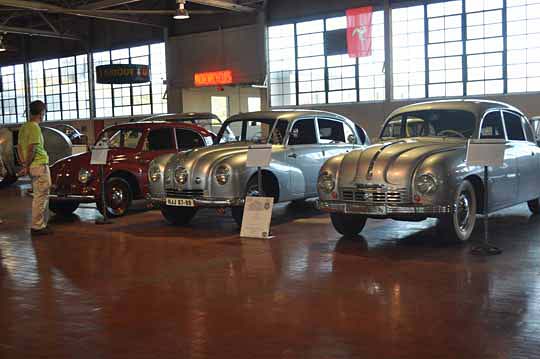
There was on display a series of cars made in Czechoslovakia, now the Czech Republic, by Tatra. This is the same company that Germany had made the propeller drive vehicle seen in page 2, the Aeroluge. Three of these cars are seen in the above photograph. A closer look follows.
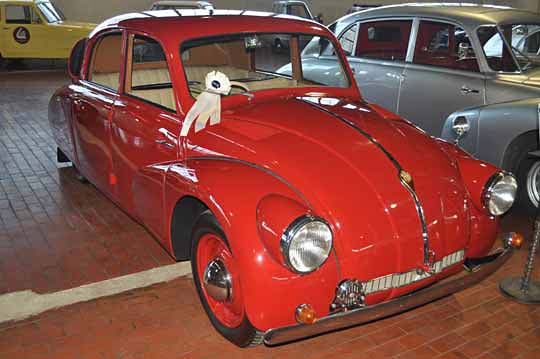
1937 Tatra T-97
The T-97 was developed along side the T-87 (next car on this page) and in effect is a slightly scaled down version of the T-87 and almost identical in style. The most obvious styling difference between the two models is the lack of the sixth window on each side of the T-97. Unlike its larger sibling, the T-97's front windshield is a single plat pane of glass and it lacks the third front headlight. The T-97 is built on a self-supporting pressed steel platform with a internal tube for added strength. The T-97 could cruise easily at 68 mph with a maximum speed of around 80 mph. These figures are most impressive for 1937 and speak volumes for the aerodynamic efficiency of the car's design. After the outbreak of World War II in 1939, production of the T-97 was forbidden due to the closeness in design to Ferdinand Porsche's Volkswagen. Only 508 examples of the T-97 were produced between 1936 and 1939.
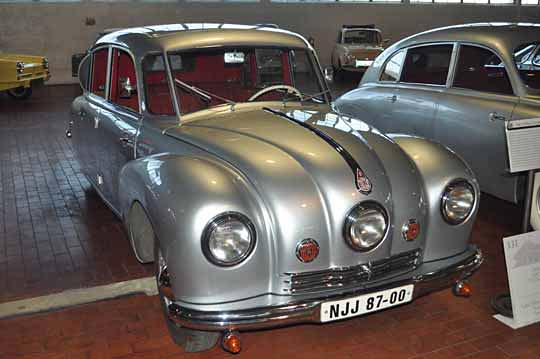
1947 Tatra T-87 Saloon
Tatra began experimenting with car aerodynamics in the early 1930s and began work on an automobile design on which decades of future Tatras were based. The Tatra T-77 was the world's first serially produced aerodynamic-styled automobile powered by an air-cooled rear mounted engine. Te T-87 pictured here began production in 1936. With the outbreak of World War II, Tatra was forced to produce military vehicles; the T-87 was allowed in limited production because it is rumored this was favored by Hitler for its high speed, remarkable traction in bad weather and its reliability on the cold eastern front. It is also rumored that so many German officers were killed behind the wheel that they were forbidden to drive the car. Notice how the windshield is flanked by small windows at the A-pillars giving the driver exceptional visibility. There is a smooth flow of body lines from the three headlights on the front hood to the elegant dorsal fin. The intake scoops allow air to flow into the rear mounted engine. This rear engine of 2968cc, V8 overhead car, produced 75 bhp and had a top speed of 100 mph.
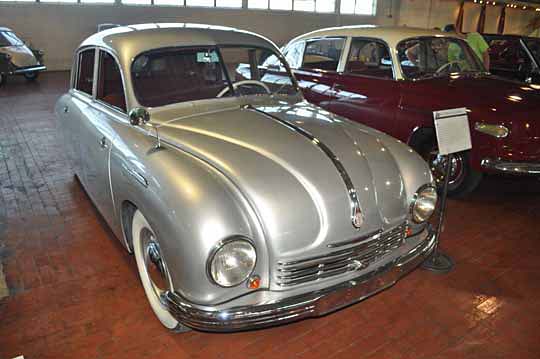
1950 Tatra T-600 Tatraplan
After World War II, Tatra found itself stranded behind the iron curtain. The T-600 was introduced at the 1947 Prague Auot Salon. After World War II, Tatra's chief designer was Julius Mackerly. He used many elements of the T-87 to design the T-600. Notice that the T-600 is slightly smaller and more economical than the T-87. The engine is a flat four cylinder, air-cooled instead of the T-87's V8. While the T-87 could maintain a higher top speed, the T-600 is easier to drive because of its lighter weight. From 1947 to 1951, more than half of the Tatrplans produced were exported to countries all around the world. IN 1951, production moved to Skoda where all the cars built were for export. Until production ceased in 1952, no luxury cars were produced in Czechoslovakia.
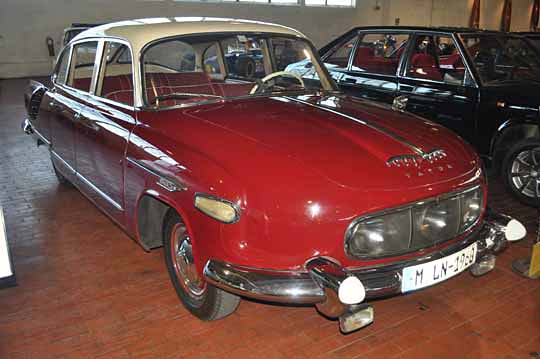
1958 Tatra T-603 Saloon
When the Czech Republic was formed, the centralized planned economy appointed the Tatra to be the manufacturer for big automobiles, cars with engine displacement over 2,000cc. It was then that work began on developing the T-603. This model was unveiled to the public in 1955 at the International Motor Event in Zlin. Production started in 1957. The T-603 which you see here has a third headlight unit although some had a fourth headlight. The body is an all steel monocoque construction lighter in weight than the T-87. This is a roomy six passenger car. Unusually, the front bench seat can be folded back to make a temporary bed. The T0603 could not be boght by private consummers as it was only for Communist officials and presidents on Eastern-European countries and Cuba.
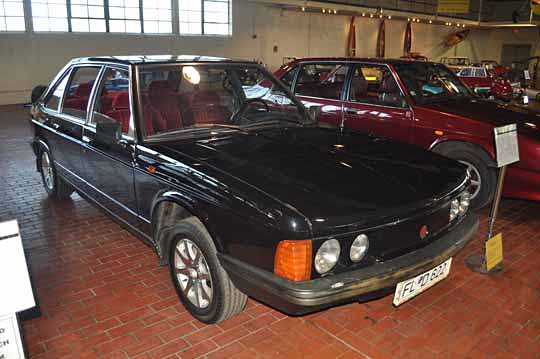
1978 Tatra T-613
In the late 1960s, it became time to start work on the design of a new Tatra to take over the role of flagship for the Communist officials. The new model — the T-613 seen here was the first Tatra styled outside the Tatra factory. Vingale of Italy did the body syling. The T-613 was the first Tatra where the engine as located above the rear axle (instead of behind it) to help improve the car's handling. The T-613 was intended for use by government officials in Communist countries. Production of the T-613 reached its peak in the late 1970s with approximately 1,500 cars produced annually. The 1980s saw production decrease to a few hundred a year. After the United Nations imposed trade sanctions with client countries and the fall of the Communist regime in Czechoslovakia, sales decreased rapidly. In 1996, only 11 cars were made. Tatra ceased car production in 1998. Now only large inductrial trucks are produced.
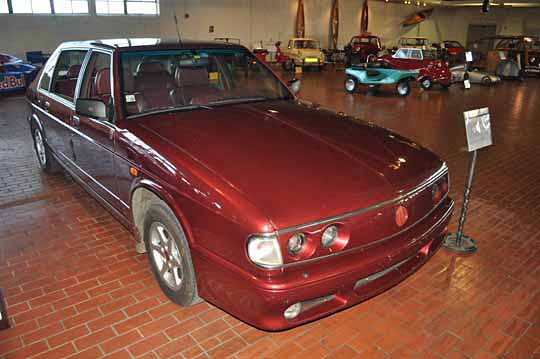
1996 Tatra T-700
The Vignale designed Tatra 613 was introduced in 1975 and was too primitive to attract Western buyers after the fall of Communism in the late 1980s, early 1990s. Tatra was evaluating two approaches to the new proposed Project T-623 — a front-engined, water cooled sedan and also a more traditional rear air-cooled option. Unfortunately, Czechoslovakia's “Velvet Revolution” of 1989 left many state-supported industries without clear direction — Tatra included.
With the T-625 project shelved, Tatra enlisted British designer Geoff Wardle to freshen the T-613 into the T-700 pictured here. The prototype was produced at the Pribor factory in 1995, and it was introduced to the public in 1996, in six variations. Many differences are visible on the exterior with smoother lines and a revised front end. More changes were evident in the engine. The first fifteen cars were built with an injected 3.5 liter engine, but the last 14 cars were even more special having a displacement of 4.3 liters, forged crankshafts, and chemically treated cylinder bores. These last few passenger cars that Tatra prouced rewarded the driver with 230 hp and 360 foot-pounds of torque. A “regular” car might take 3.5 hours to cover the 350 kilometers from Prague to Koprivnice, but the over two-ton Tatra T-700 was able to travel that distance in under 2.5 hours!
A much needed front axle redesign was on the drawing board when Tatra pulled the plug on passenger car production. Heavy commercial and military trucks are still produced by the factory but, sadly, the world will never know what interesting passenger cars might have come from the inventive minds a Tatra.
Our visit to the Lane Motor Museum was very interesting as we got to see some cars never seen before. Thanks to Lane for the display and providing the information that enable me to write what you have read here. Yes, there was some wordsmithing but for the most part what you read here can be seen in the Museum. It was intersting to see the world map marked with the hometown of the Museum visitor. The little town where I grew up in Texas was even represented.
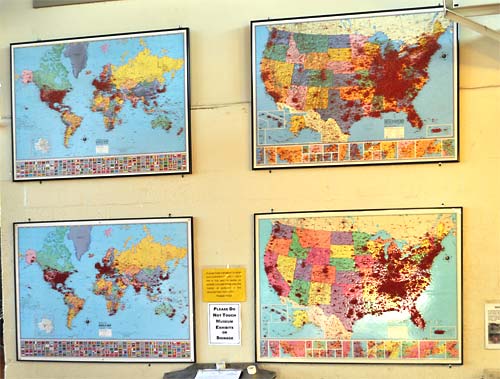
Don't Miss If in Nashville the Lane Motor Museum
Back to the first page cars.
Let's go on to a second page for some really “mini-sized” cars.
Onward to page three for a really UGLY car & some very cool.
Onward to page four for more on Tatra of Czechoslovakia.